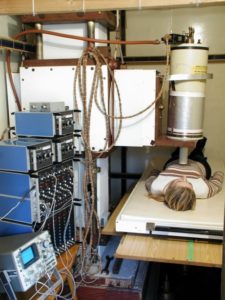
- Weak superconductivity – Josephson junctions, RF and DC SQUIDs
- High temperature supeconductivity (HTSc) – synthesis of (nano)precursors, production of sputtering targets of thin layers, synthesis of bulk REBa2Cu3-xMxO3-d systems, technology development of monodomain samples for applications
- Measurement of extremely weak magnetic fields – supraconducting quantum magnetometers, gradiometric antenna systems, biomagnetic fields
- Development of SQUID magnetometric methods for magnetic nanoparticles and nanoliquids
- Measurement of the transition (by using tranport and inductance method) and thermoelectrical characteristics of HTSc
Results:
- Design and verification of the measuring system of original conception for measurement and analysis of magnetic characteristics of the HTSc using superconducting quantum magnetometer with the SQUID sensor and superconducting gradiometric antenna of the 2nd order
- Investigation of properties of high-Tc superconductors
- Combined methods of compensation of the disturbing signals in measurement of extremely weak magnetic fields in a magnetically unshielded environment, methods of determination of low concentrations of the ferro(ferri-) magnetic substances in the biological objects in a noninvasive way (lung dust loads and liver iron content measurements), biomonitoring of the environment based on magnetometry
- Microstructural analysis of HTSc
Special equipments:
- 5-channel low-Tc DC SQUID system with equivalent sensitivity of ~20×10-15 T Hz-1/2 in the white noise range (gradiometers’ diameter: 14mm, SQUIDs from FSU Jena – Germany)
- One-channel low-Tc RF SQUID system with equivalent sensitivity of ~20×10-15 T Hz-1/2 in the white noise range (gradiometer’s diameter: 40mm, SQUID of own production)
- System for measurement of magnetic properties of materials using SQUID: QD-MPMS-XL-7AC. Range of applied DC field: +/- 7 T, sensitivity: 10-11Am2 for applied fields (0 T – 0.25 T)
Cooperations:
- Institute of Electrical Engineering, SAS, Bratislava (web)
- Department of Inorganic Chemistry, Faculty of Natural Sciences, Comenius University, Bratislava (web)
- Institute of Pathological Anatomy, Faculty of Medicine, Comenius University, Bratislava (web)
- Department of Inorganic and Physical Chemistry, Ghent University, Belgium (web)
- Radiodiagnostic Clinic, Academician Ladislav Derer Hospital, Bratislava
 Contacts
Contacts Intranet
Intranet SK
SK